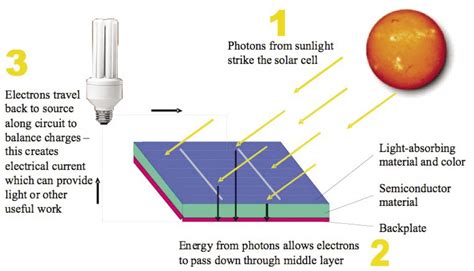Harnessing the power of the sun
When it comes to renewable energy sources, harnessing the power of the sun is one of the most promising and widely adopted methods. Solar energy has the potential to revolutionize the way we generate electricity and reduce our dependence on fossil fuels. By converting the sun’s rays into usable electricity, solar panels have become the building blocks of this clean and sustainable energy revolution.
One of the key factors behind solar panels’ ability to generate electricity is the photovoltaic effect. This process involves the conversion of sunlight into electric current using semiconductors. Semiconductors are materials that have properties between those of conductors and insulators, allowing them to conduct electricity under certain conditions. In solar panels, the semiconductors absorb photons from the sunlight, exciting the electrons and generating an electric current.
The flow of electrons within a solar panel follows a specific path, enabling the conversion of sunlight into electricity. When photons from the sun’s rays strike the semiconducting material in the solar panels, they knock loose electrons from the atoms. These free electrons then flow in a specific direction due to the built-in electric field created within the solar cells. This flow creates a direct current (DC) that can be used to power various devices and stored in batteries for later use.
Solar panels: the building blocks
Solar panels are the key components of a solar energy system. They are responsible for converting sunlight into usable electricity, making them the building blocks of solar power generation. Solar panels utilize the photovoltaic effect, which is the process of converting light energy into electrical energy using semiconductors. This article will delve into the structure and functioning of solar panels, as well as their importance in harnessing solar power.
To understand how solar panels work, it is important to comprehend the photovoltaic effect. The photovoltaic effect is the phenomenon where certain materials, such as silicon, generate an electric current when exposed to sunlight. This occurs due to the interaction between photons (particles of light) and electrons in the semiconductor material.
Solar panels are made up of multiple interconnected solar cells, which are responsible for converting sunlight into electrical energy. Each solar cell consists of a layer of p-type semiconductor material and a layer of n-type semiconductor material, creating a pn junction. The p-type material contains positively charged particles, while the n-type material contains negatively charged particles. When sunlight hits the solar cell, photons transfer their energy to the electrons in the semiconductor material.
This energy transfer excites the electrons in the p-type material, causing them to break free from their atoms and create free electrons. Due to the pn junction, these free electrons are forced to flow towards the n-type material, creating an electric current. This flow of electrons is then captured by a metal grid on the surface of the solar cell and conducted out of the solar panel as usable electricity.
In order to optimize the electricity generated by solar panels, inverter technology is used to convert the direct current (DC) produced by the panels into alternating current (AC) that can be used in homes and businesses. Additionally, monitoring systems allow the performance of solar panels to be tracked and optimized, ensuring maximum energy production and efficiency.
In conclusion, solar panels are the fundamental building blocks of solar energy systems. Through the photovoltaic effect and the use of semiconductors, solar panels are able to harness sunlight and convert it into electrical energy. By understanding the structure and function of solar panels, we can appreciate their vital role in generating clean and sustainable power from the sun.
Photovoltaic effect: converting sunlight into electricity
The photovoltaic effect is the phenomenon by which sunlight is converted into electricity. This process occurs within solar panels, which are composed of photovoltaic cells. When sunlight hits these cells, it is absorbed by semiconductors, usually made of silicon. These semiconductors have two layers: the p-type and the n-type. The p-type semiconductor has an excess of positive charges, while the n-type semiconductor has an excess of negative charges. This imbalance creates an electric field between the two layers.
As sunlight passes through the semiconductor layers, its energy is transferred to the electrons in the atoms of the material. This energy allows the electrons to become excited and break free from their atoms, creating free electrons and leaving behind holes. The electric field within the photovoltaic cell then pushes the free electrons towards the n-type layer and the holes towards the p-type layer, creating a flow of electric current.
In order to harness this electric current, metal contacts are attached to both the p-type and n-type layers of the photovoltaic cell. These contacts allow the current to be extracted and utilized for powering various devices. The flow of electrons from the solar panel can be direct current (DC), which is the type of electricity produced by the photovoltaic effect. However, most household appliances and the electrical grid operate on alternating current (AC). Therefore, an inverter is used to convert the DC electricity into AC electricity, making it compatible with the standard electrical systems.
- The photovoltaic effect is the process by which sunlight is converted into electricity.
- Solar panels are made up of photovoltaic cells that contain semiconductors.
- The photovoltaic cells absorb sunlight and create an electric field.
- The energy from sunlight causes electrons to become excited and create a flow of electric current.
- Metal contacts on the photovoltaic cell allow the current to be extracted and used.
- An inverter is required to transform the produced DC electricity into AC electricity.
| Pros | Cons |
|---|---|
| Renewable energy source | Initial installation costs |
| Reduces reliance on fossil fuels | Space requirements |
| Low maintenance | Dependent on sunlight availability |
| Long lifespan | Environmental impact of manufacturing |
The role of semiconductors in solar panels
The role of semiconductors in solar panels is crucial in enabling the conversion of sunlight into electricity. Semiconductors are materials that have properties between conductors and insulators, allowing them to selectively conduct electrical current. In solar panels, semiconductors play a key role in capturing, absorbing, and converting sunlight energy into usable electrical energy.
Solar panels are made up of several layers, with the semiconductor material typically found in the photovoltaic (PV) cells. The two most commonly used semiconductors in solar panels are silicon and thin-film materials such as cadmium telluride (CdTe) or copper indium gallium selenide (CIGS).
Within the PV cells, semiconductors are doped to create specific electron imbalances, either by adding impurities with extra electrons (n-type) or creating a deficit of electrons (p-type). This process creates a built-in electric field that generates an electric potential when sunlight strikes the cell. The photons from the sunlight excite the electrons in the semiconductor, allowing them to break free and flow as an electric current.
Understanding the flow of electrons
The flow of electrons is a fundamental concept in understanding how solar panels work to generate electricity. When sunlight hits the solar panels, it excites the electrons in the semiconductors, generating an electric current. This flow of electrons is crucial in harnessing solar energy. Let’s explore the process in more detail.
In a solar panel, multiple layers of semiconductors, such as silicon, are sandwiched together. These semiconductors have impurities that create regions with either an excess or a deficiency of electrons. The top layer is typically doped with phosphorus, which introduces extra electrons, creating an excess. This creates an n-type semiconductor. The bottom layer, on the other hand, is doped with boron, which creates a deficiency of electrons, resulting in a p-type semiconductor. The region where the two layers meet is called the p-n junction.
When sunlight reaches the solar panel, it is composed of photons or light particles. These photons carry energy, and when they strike the surface of the solar panel, their energy is absorbed by the atoms in the semiconductors. This absorption causes the electrons to break free from their atoms and move across the material, creating a flow of current. However, these electrons are not allowed to move freely across the panel.
The structure of the solar panel ensures that the flow of electrons is directional. One side of the p-n junction has an excess of electrons, while the other side has a deficiency. When sunlight causes an electron to break free from an atom, it creates a positive charge in the atom it leaves behind. This positive charge attracts the free electrons from the neighboring atoms, creating a domino effect. As a result, the excess electrons move towards the p-n junction, and the deficient electrons move away from it.
This directional movement of electrons creates an electric field across the solar panel. This electric field allows the electrons to flow in one direction and prevents them from moving back. The electrons travel through a conductive material within the panel called the metal contacts. These contacts are connected to wires, allowing the current to be harnessed and used for various applications.
Inverter technology: transforming DC to AC
Inverter technology plays a crucial role in the functioning of solar energy systems. As solar panels produce Direct Current (DC), it needs to be converted into Alternating Current (AC) in order to be used in homes and businesses. This is where inverters come into play.
The primary function of an inverter is to convert the DC electricity generated by solar panels into usable AC electricity. It accomplishes this by using a complex electronic circuit that changes the frequency and voltage of the electricity. This transformation is essential because most household appliances and electrical systems are designed to operate on AC power.
Inverters are not only responsible for converting DC to AC but also for ensuring the optimal performance of solar energy systems. They monitor the flow of electricity, adjust voltage levels, and protect against power surges or irregularities. Additionally, modern inverters often come equipped with advanced features that enable remote monitoring and optimization of solar energy production.
When selecting an inverter for your solar energy system, it is important to consider factors such as efficiency, reliability, and compatibility with your specific requirements. There are three main types of inverters commonly used in solar panel installations:
- String inverters: These are the most traditional type of inverters and are suitable for residential and small commercial installations. They connect multiple solar panels together in a series, converting the combined DC power into AC power.
- Microinverters: Unlike string inverters, microinverters are attached to individual solar panels. This allows each panel to operate independently, maximizing energy production and minimizing the impact of shading or malfunctions.
- Power optimizers: Power optimizers are similar to microinverters as they are installed on each solar panel. However, instead of directly converting DC to AC, they optimize the power output of each individual panel before being fed into a central inverter.
In conclusion, inverter technology plays a vital role in transforming the DC electricity generated by solar panels into usable AC electricity. It ensures the efficient and safe operation of solar energy systems by monitoring and adjusting the flow of electricity. When choosing an inverter, it is important to consider factors such as compatibility and efficiency. By harnessing the power of inverter technology, we can make the most of solar energy and contribute to a cleaner and more sustainable future.
Monitoring and optimizing solar energy production
Solar energy production is becoming increasingly popular as a sustainable and efficient alternative to traditional energy sources. As more and more individuals and businesses make the switch to solar power, it becomes essential to monitor and optimize the production of solar energy to ensure maximum efficiency and cost-effectiveness. This blog post will explore various techniques and technologies that can be utilized to monitor and optimize solar energy production.
One of the key aspects of monitoring solar energy production is collecting and analyzing data. By carefully tracking various parameters such as solar irradiance, temperature, and panel efficiency, it becomes possible to identify patterns and make informed decisions regarding system optimization. This data can be collected using sensors placed strategically within the solar power system and can be further processed using specialized software.
Once the data has been collected and analyzed, it is important to identify any potential issues or areas for improvement. Regular inspections and maintenance of the solar panels and associated equipment are crucial to ensure their optimal performance. This includes checking for dust or dirt accumulation on the panels, inspecting for any physical damage, and monitoring the performance of individual panels to identify any underperforming units.
The positive impact of solar energy
The positive impact of solar energy is a topic that has gained significant attention in recent years. As the world continues to search for clean and sustainable sources of power, solar energy has emerged as a leading contender. Solar energy refers to the power generated from the sun’s rays, which is harnessed using solar panels. This renewable energy source offers a number of benefits, both for individuals and for the environment.
One of the most significant advantages of solar energy is its environmental impact. Unlike traditional sources of electricity, such as coal or natural gas, solar energy does not produce harmful greenhouse gas emissions. This means that harnessing solar power does not contribute to air pollution or climate change. In a world grappling with the devastating effects of global warming, solar energy offers a clean and sustainable alternative that can help mitigate these issues.
In addition to its positive environmental impact, solar energy also has numerous benefits for individuals and communities. Investing in solar panels for your home or business can result in significant savings on electricity bills. By generating your own electricity, you can reduce or even eliminate your reliance on the grid, thereby reducing your monthly expenses. Furthermore, many governments and utility companies offer incentives and subsidies to encourage the adoption of solar energy, making it an even more cost-effective option.
Frequently Asked Questions
Question 1: How do solar panels harness the power of the sun?
Solar panels harness the power of the sun through the photovoltaic effect, which allows them to convert sunlight into electricity.
Question 2: What are the building blocks of solar panels?
The building blocks of solar panels are solar cells, which are made of semiconductors that can absorb sunlight and convert it into electricity.
Question 3: How do semiconductors play a role in solar panels?
Semiconductors in solar panels help to absorb sunlight and generate an electric current by allowing the flow of electrons when exposed to sunlight. They are the essential components in the conversion of sunlight to electricity.
Question 4: How does the photovoltaic effect convert sunlight into electricity?
The photovoltaic effect in solar panels involves the absorption of sunlight particles called photons by the semiconductors. This absorption causes the release of electrons, creating an electric current that can be used as electricity.
Question 5: What is the role of inverter technology in solar panels?
Inverter technology plays a crucial role in solar panels by converting the direct current (DC) electricity generated by the panels into alternating current (AC) electricity, which is the type of electricity used in homes and businesses.
Question 6: How can solar energy production be monitored and optimized?
Solar energy production can be monitored and optimized through the use of monitoring systems that track the performance of solar panels and identify any issues or inefficiencies. By analyzing this data, adjustments can be made to maximize the energy production of the solar panels.
Question 7: What are the positive impacts of solar energy?
Solar energy has several positive impacts, including reducing greenhouse gas emissions, decreasing dependence on fossil fuels, and contributing to a cleaner and more sustainable energy future. It also helps to lower electricity bills and create job opportunities in the renewable energy sector.





